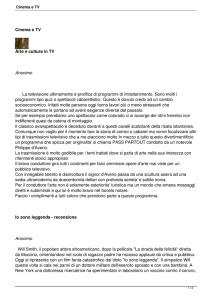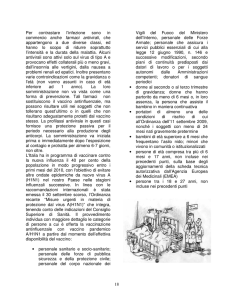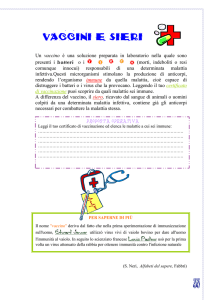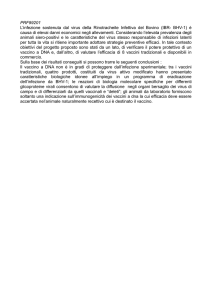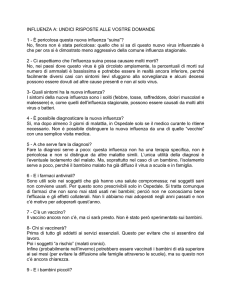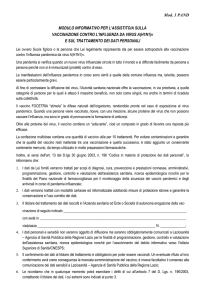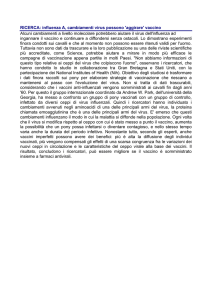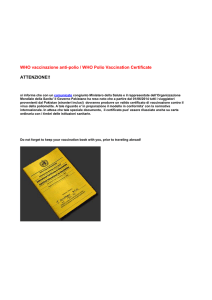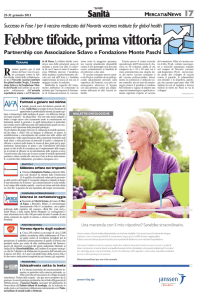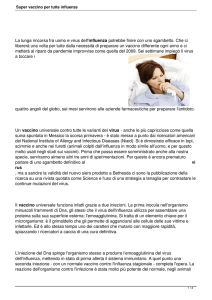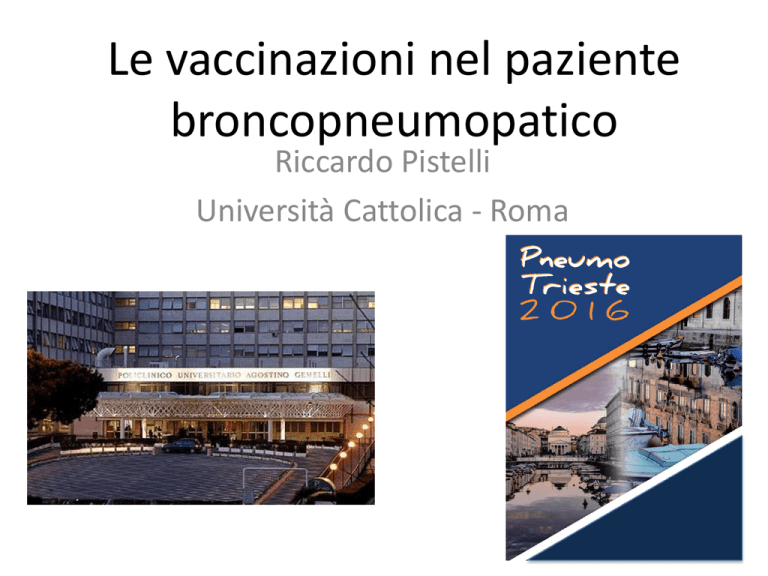
Le vaccinazioni nel paziente
broncopneumopatico
Riccardo Pistelli
Università Cattolica - Roma
Vaccinazione antinfluenzale e rischio di
ospedalizzazione negli anziani
Ann Intern Med 1995
Vaccinazione antinfluenzale e mortalità negli anziani
Ann Intern Med 1995
Vaccino antipneumococcico e salute
negli anziani
Arch Intern Med, 1999
RR
Lower limit Upper limit
Pneumoc Vac 0.57
& Hosp.
0.38
0.84
Pneumoc Vac 0.71
& Death
0.56
0.91
0.28
0.14
0.58
0.18
0.11
0.31
Pneumoc +
Flu Vac & H
Pneumoc +
Flu Vac &
Death
Bonten MJM et al. N Engl J Med 2015;372:1114-25.
CONCLUSIONS
Among older adults, PCV13 was effective in preventing vaccine-type
pneumococcal, bacteremic, and nonbacteremic communityacquired pneumonia and vaccine- type invasive pneumococcal
disease but not in preventing community-acquired pneumonia from
any cause. (Funded by Pfizer; CAPITA ClinicalTrials.gov number
NCT00744263.)
Figure 1: Pre- and post-vaccination antibody titers against HA1, HA2, and HB. Group A, patients
without corticosteroid therapy; Group B, patients with oral corticosteroid therapy; and Group C, patients with inhaled corticosteroid therapy
Somito Inoue et al EXCLI Journal 2013;12:760-765 –
Global Strategy for Diagnosis, Management and Prevention of COPD
Therapeutic Options: Key Points
Appropriate pharmacologic therapy can reduce COPD
symptoms, reduce the frequency and severity of
exacerbations, and improve health status and
exercise tolerance.
None of the existing medications for COPD has been
shown conclusively to modify the long-term decline
in lung function.
Influenza and pneumococcal vaccination should be
offered depending on local guidelines.
© 2015 Global Initiative for Chronic Obstructive Lung Disease
Pneumococcal vaccination and an annual influenza vaccination should be offered to all patients
with COPD as recommended by the Chief Medical Officer.
1. Comput Methods Programs Biomed. 2013 Aug;111(2):507-11. doi:
10.1016/j.cmpb.2013.05.006. Epub 2013 Jun 12.
Influenza vaccination and reduction in risk of ischemic heart disease among
chronic obstructive pulmonary elderly.
Huang CL(1), Nguyen PA, Kuo PL, Iqbal U, Hsu YH, Jian WS.
2. Vaccine. 2014 Jun 24;32(30):3843-9. doi: 10.1016/j.vaccine.2014.04.064. Epub
2014
May 14.
Influenza vaccination reduces hospitalization for acute coronary syndrome in
elderly patients with chronic obstructive pulmonary disease: a population-based
cohort study.
Sung LC(1), Chen CI(2), Fang YA(3), Lai CH(4), Hsu YP(4), Cheng TH(5), Miser
JS(6), Liu JC(7).
Circulation. 2012;125:773-781
Barnes M et al. Heart 2015
Barnes M et al. Hearth 2015
1. Che cos’è l’influenza?
L'influenza è una malattia provocata da virus (virus influenzali) che infettano le vie
aeree (naso, gola, polmoni). Spesso vengono impropriamente etichettate come
"influenza" diverse affezioni delle prime vie respiratorie, sia di natura batterica che
virale, che possono presentarsi con sintomi molto simili. Nello stesso periodo dell'anno
in cui la circolazione dei virus influenzali è massima (in Italia solitamente in
autunno‐inverno) possono contemporaneamente circolare molti altri virus che
provocano affezioni del tutto indistinguibili, dal punto di vista clinico, dall'influenza
(Adenovirus, Rhinovirus, virus sinciziale respiratorio etc.).
La vaccinazione costituisce la principale misura di prevenzione.
I vaccini antinfluenzali disponibili in Italia
I vaccini disponibili in Italia sono tutti inattivati* e quindi non contengono particelle virali intere attive e sono
classificabili nei seguenti tipi:
• vaccino split, contenente virus influenzali frammentati
• vaccino a subunità, contenente solo gli antigeni di superficie, emoagglutinina e neuraminidasi
• vaccino adiuvato, contenente gli antigeni di superficie emulsionati ad adiuvante oleoso metabolizzabile
(MF59)
• vaccino intradermico, è un vaccino split, confezionato in una siringa particolare che consente di inoculare nel
derma la dose di 15 μg/ceppo concentrata in 0,1 ml di volume.
Dal 2014 è disponibile in commercio in Italia un vaccino quadrivalente split indicato per l’immunizzazione degli
adulti e dei bambini dai 3 anni di età, per la prevenzione della influenza causata dai due sottotipi di virus
influenzale A e da due di tipo B.
I vaccini stagionali adiuvati con MF59 sono autorizzati, al momento, per l’immunizzazione dei soggetti di età ≥64
anni. La funzione degli adiuvanti è quella di potenziare la risposta immunitaria alla vaccinazione; per questo
trovano particolare indicazione per l’immunizzazione dei soggetti anziani e di quelli poco rispondenti.
Il vaccino intradermico sfrutta i particolari meccanismi immunitari che si attivano nel derma e potenziano la
risposta immunitaria anche nei pauci‐rispondenti alla somministrazione intramuscolare.
È, inoltre, disponibile in commercio un vaccino inattivato prodotto in colture cellulari.
* ad eccezione di un vaccino antinfluenzale costituito da virus vivi attenuati, da somministrare per via nasale
(nome commerciale Fluenz), autorizzato al commercio in Italia.
I vaccini antipneumococco
disponibili in Italia
Raccomandazioni per la somministrazione di PCV13
• Quando somministrato da solo o per primo in un’eventuale schedula
sequenziale, in adulti >50 anni, PCV13 può dare i migliori vantaggi
immunologici derivanti dal fattodi essere un vaccino coniugato
• La capacità di priming pone PCV13 come nuova opportunità per soggetti che
siano stati vaccinati in precedenza con PPV23
• In particolare, PCV13 può essere raccomandato per adulti ≥50 anni
indipendentemente dalla loro storia vaccinale:
• adulti naïve per il vaccino PPV23
• adulti precedentemente vaccinati (>1anno) con PPV23;
• adulti di cui non è nota la storia vaccinale.
• Una dose di PPV dovrebbe eventualmente seguire, e mai precedere, quella di
PCV13. Tale sequenzialità non dovrebbe essere inferiore a 8 settimane nei
soggetti a rischio (negli studi registrativi dell’adulto i dati sono peraltro relativi
a un anno tra le dosi).
Prevention and Control of Seasonal Influenza with Vaccines: Recommendations of
the Advisory Committee on Immunization Practices — United States, 2015-2016
SUMMARY
This report updates the 2012 recommendations by CDC's Advisory Committee on Immunization Practices
(ACIP) regarding the use of influenza vaccines for the prevention and control of seasonal influenza (CDC.
Prevention and control of influenza with vaccines: recommendations of the Advisory Committee on
Immunization Practices [ACIP]. MMWR 2012;61:613–8).
Routine annual influenza vaccination is recommended for all persons aged ≥6
months. For the 2013–14 influenza season, it is expected that trivalent live attenuated influenza vaccine
(LAIV3) will be replaced by a quadrivalent LAIV formulation (LAIV4). Inactivated influenza vaccines (IIVs) will
be available in both trivalent (IIV3) and quadrivalent (IIV4) formulations.
Vaccine virus strains included in the 2013–14 U.S. trivalent influenza vaccines will be an A/California/7/2009
(H1N1)–like virus, an H3N2 virus antigenically like the cellpropagated prototype virus A/Victoria/361/2011,
and a B/Massachusetts/2/2012–like virus. Quadrivalent vaccines will include an additional influenza B virus
strain, a B/Brisbane/60/2008–like virus, intended to ensure that both influenza B virus antigenic lineages
(Victoria and Yamagata) are included in the vaccine. This report describes recently approved vaccines,
including LAIV4, IIV4, trivalent cell culturebased inactivated influenza vaccine (ccIIV3), and trivalent
recombinant influenza vaccine (RIV3). No preferential recommendation is made for one influenza vaccine
product over another for persons for whom more than one product is otherwise appropriate. This
information is intended for vaccination providers, immunization program personnel, and public health
personnel. These recommendations and other information are available at CDC's influenza website
(http://www.cdc.gov/flu); any updates also will be found at this website. Vaccination and healthcare
providers should check the CDC influenza website periodically for additional information.
Should Patients With COPD Be Vaccinated?
Pinar Cimen MD, Mehmet Unlu MD, Cenk Kirakli MD, Nuran Katgi MD,
Fatma Demirci Ucsular MD, Aysu Ayranci MD, and Salih Zeki Guclu MD
BACKGROUND: Exacerbations of COPD are a major component of the socioeconomic burden related to COPD, and frequent
exacerbations are associated with greater decline in health status. Tracheobronchial infections are involved in 50–70% of
exacerbations, so influenza and pneumococcal vaccines are recommended for prevention. The aim of this study was to determine
the level of knowledge among COPD patients about the vaccines, find the rate of patients inoculated with both influenza and
pneumococcal vaccines, and assess the effectiveness of vaccination status.
METHODS: Patients with COPD were recruited from the out-patient clinic of our hospital between September and October 2012.
Subject demographic data such as age, gender, level of education, and smoking status were recorded. Vaccination status, number
of subjects who were informed by a health-care professional about immunization, and COPD-related emergency or hospital
admissions triggered by tracheobronchial infections over 1 y after administration of both influenza and pneumococcal vaccines
were noted.
RESULTS: Eighty-eight subjects were enrolled during the study period. Eighty-two subjects were male (93.2%), 6 subjects were
female (6.8%), and the median age was 61.5 y. According to Global Initiative for Chronic Obstructive Lung Disease (GOLD) 2006
classification, 5 subjects were in stage 1 (5.7%), 22 subjects were in stage 2 (25%), 34 subjects were in stage 3 (38.6%), and 27
subjects were in stage 4 (30.7%). Sixty-two subjects had graduated from primary school (70.5%), 21 subjects had graduated from
high school (23.9%), one subject had graduated from university (1.1%), and 4 subjects had no education (4.5%). Forty-five subjects
(51%) were vaccinated. There was no significant correlation between level of education and vaccination status (P ! .37). Both
COPD-related emergency department and hospital visits were significantly decreased in vaccinated patients with COPD (P < .001
and P ! .02, respectively). Of all the subjects, 39.7% (35 of 88 subjects) mentioned that no health-care professional
recommended vaccination.
CONCLUSIONS: Physicians should be more aware of vaccination and recommend both influenza and pneumococcal vaccines to all
patients with COPD to reduce exacerbations.
Respir Care 2015;60(2):239 –243. © 2015
B Make et al. International Journal of COPD 2012:7 1–9
B Make et al. International Journal of COPD 2012:7 1–9
Vaccinazione antinfluenzale nel
Lazio negli anziani
25,0
20,0
15,0
% sul totale
10,0
5,0
0,0
1996
1997
1998
1999
Copertura vaccinale in Italia
Conclusioni
•
•
•
•
•
•
•
Le vaccinazioni antinfluenzale e antipneumococcica sono uniformemente
suggerite dalle autorità sanitarie al fine di migliorare le condizioni di salute dei
pazienti affetti da patologie polmonari croniche.
La reale applicazione della pratica vaccinale è assai inferiore a quella prevedibile
sulla base dei suggerimenti summenzionati, e in costante diminuzione negli ultimi
10 anni.
Si deve tuttavia ammettere che l’evidenza scientifica a supporto di questi
suggerimenti ha una qualità spesso non elevata.
La vasta disponibilità sul web di notizie e ammonizioni, spesso puramente
ideologiche, sugli effetti negativi della pratica vaccinale contribuisce in modo
rilevante all’uso sottodimensionato dei vaccini.
Si ritiene necessario che le autorità sanitarie contrastino questa
controinformazione con una informazione corretta che derivi dalla miglior
evidenza scientifica disponibile.
E’ tuttavia necessario implementare studi di coorte che apportino evidenze
aggiornate e di elevata qualità sulle pratiche vaccinali suggerite dalle autorità
sanitarie.
Nel breve periodo, studi caso-controllo adeguatamente disegnati potrebbero
supplire alla carenza di dati di qualità scientifica consona all’importanza del tema.

